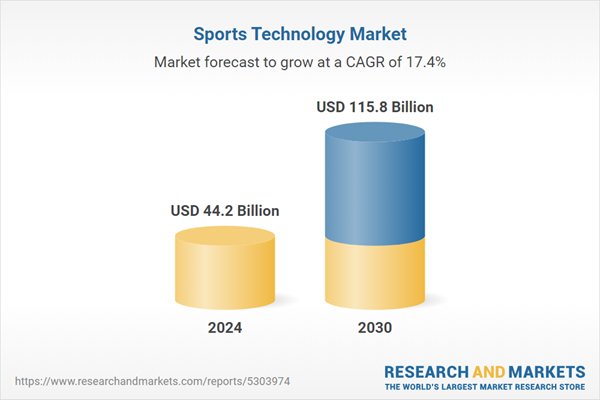The global market for Sports Technology was valued at US$44.2 Billion in 2024 and is projected to reach US$115.8 Billion by 2030, growing at a CAGR of 17.4% from 2024 to 2030. This comprehensive report provides an in-depth analysis of market trends, drivers, and forecasts, helping you make informed business decisions. The report includes the most recent global tariff developments and how they impact the Sports Technology market.
Segments: Technology (Smart Stadiums, Devices, Sports Analytics, eSports).
Geographic Regions/Countries: World; United States; Canada; Japan; China; Europe (France; Germany; Italy; United Kingdom; and Rest of Europe); Asia-Pacific; Rest of World.
The analysts continuously track trade developments worldwide, drawing insights from leading global economists and over 200 industry and policy institutions, including think tanks, trade organizations, and national economic advisory bodies. This intelligence is integrated into forecasting models to provide timely, data-driven analysis of emerging risks and opportunities.
Global Sports Technology Market - Key Trends and Drivers Summarized
How Is Sports Technology Transforming Athletic Performance and Fan Engagement?
Sports technology encompasses a range of innovations that improve athletic performance, enhance fan experiences, and optimize sports management. These technologies include wearable devices, performance analytics software, video analysis tools, virtual reality (VR), and artificial intelligence (AI)-driven coaching systems. By providing real-time data, insights, and training solutions, sports technology enables athletes, coaches, and teams to achieve optimal performance levels while improving injury prevention, recovery, and training efficiency. As technology evolves, the sports industry continues to embrace digital transformation, leveraging tools that enhance both professional and recreational sports.What Are the Key Segments in the Sports Technology Market?
Key types include wearable devices, analytics software, e-sports technology, and sports equipment, with wearable devices holding the largest market share due to their widespread use in monitoring athletic performance and fitness levels. Applications cover athlete performance tracking, fan engagement, stadium management, and e-sports, with athlete performance tracking representing a significant segment driven by the need for real-time data to optimize training. End-users include professional teams, sports academies, individual athletes, and fitness centers, with professional teams leading the market as they invest in data-driven decision-making to improve competitive outcomes.How Is Sports Technology Integrated Across Sports?
In professional sports, wearable devices and analytics software track players' performance metrics like speed, heart rate, and recovery time, helping coaches tailor training programs and game strategies. E-sports organizations use advanced technology to enhance gaming experiences, including VR for immersive training, AI for strategic gameplay analysis, and cloud-based solutions for global connectivity. In stadium management, smart technologies like crowd analytics, digital ticketing, and fan engagement apps improve safety, convenience, and interaction during live events. Additionally, fitness centers integrate sports technology through connected equipment, virtual training programs, and digital coaching, offering personalized workout plans and progress tracking.What Factors Are Driving the Growth in the Sports Technology Market?
The growth in the Sports Technology market is driven by several factors, including increasing demand for data-driven performance optimization and fan engagement solutions in professional sports. Advancements in wearable sensors, AI algorithms, and immersive experiences like VR have improved the accuracy, efficiency, and appeal of sports technology, supporting broader adoption across sports organizations and fitness centers. The focus on improving athlete performance, reducing injury risks, and enhancing fan experiences has further fueled demand, as stakeholders prioritize innovation and digital transformation. Additionally, rising investments in sports infrastructure, increased participation in recreational activities, and the popularity of e-sports have contributed to market growth, encouraging the integration of advanced sports technologies.Report Scope
The report analyzes the Sports Technology market, presented in terms of units. The analysis covers the key segments and geographic regions outlined below.Segments: Technology (Smart Stadiums, Devices, Sports Analytics, eSports).
Geographic Regions/Countries: World; United States; Canada; Japan; China; Europe (France; Germany; Italy; United Kingdom; and Rest of Europe); Asia-Pacific; Rest of World.
Key Insights:
- Market Growth: Understand the significant growth trajectory of the Smart Stadiums segment, which is expected to reach US$72.8 Billion by 2030 with a CAGR of a 18.1%. The Devices segment is also set to grow at 14.9% CAGR over the analysis period.
- Regional Analysis: Gain insights into the U.S. market, valued at $12.4 Billion in 2024, and China, forecasted to grow at an impressive 16.4% CAGR to reach $17.3 Billion by 2030. Discover growth trends in other key regions, including Japan, Canada, Germany, and the Asia-Pacific.
Why You Should Buy This Report:
- Detailed Market Analysis: Access a thorough analysis of the Global Sports Technology Market, covering all major geographic regions and market segments.
- Competitive Insights: Get an overview of the competitive landscape, including the market presence of major players across different geographies.
- Future Trends and Drivers: Understand the key trends and drivers shaping the future of the Global Sports Technology Market.
- Actionable Insights: Benefit from actionable insights that can help you identify new revenue opportunities and make strategic business decisions.
Key Questions Answered:
- How is the Global Sports Technology Market expected to evolve by 2030?
- What are the main drivers and restraints affecting the market?
- Which market segments will grow the most over the forecast period?
- How will market shares for different regions and segments change by 2030?
- Who are the leading players in the market, and what are their prospects?
Report Features:
- Comprehensive Market Data: Independent analysis of annual sales and market forecasts in US$ Million from 2024 to 2030.
- In-Depth Regional Analysis: Detailed insights into key markets, including the U.S., China, Japan, Canada, Europe, Asia-Pacific, Latin America, Middle East, and Africa.
- Company Profiles: Coverage of players such as Adidas AG, Apple, Cisco, Ericsson, Fitbit and more.
- Complimentary Updates: Receive free report updates for one year to keep you informed of the latest market developments.
Some of the 68 companies featured in this Sports Technology market report include:
- Adidas AG
- Apple
- Cisco
- Ericsson
- Fitbit
- IBM
- LG
- NEC
- PlaySight Interactive Ltd.
- Samsung
- SAP SE
- Sony Corporation
- STATS LLC
- STRIVR Labs
- ZEPP
Tariff Impact Analysis: Key Insights for 2025
Global tariff negotiations across 180+ countries are reshaping supply chains, costs, and competitiveness. This report reflects the latest developments as of April 2025 and incorporates forward-looking insights into the market outlook.The analysts continuously track trade developments worldwide, drawing insights from leading global economists and over 200 industry and policy institutions, including think tanks, trade organizations, and national economic advisory bodies. This intelligence is integrated into forecasting models to provide timely, data-driven analysis of emerging risks and opportunities.
What’s Included in This Edition:
- Tariff-adjusted market forecasts by region and segment
- Analysis of cost and supply chain implications by sourcing and trade exposure
- Strategic insights into geographic shifts
Buyers receive a free July 2025 update with:
- Finalized tariff impacts and new trade agreement effects
- Updated projections reflecting global sourcing and cost shifts
- Expanded country-specific coverage across the industry
Table of Contents
I. METHODOLOGYII. EXECUTIVE SUMMARY2. FOCUS ON SELECT PLAYERSIII. MARKET ANALYSISIV. COMPETITION
1. MARKET OVERVIEW
3. MARKET TRENDS & DRIVERS
4. GLOBAL MARKET PERSPECTIVE
UNITED STATES
CANADA
JAPAN
CHINA
EUROPE
FRANCE
GERMANY
ITALY
UNITED KINGDOM
REST OF EUROPE
ASIA-PACIFIC
REST OF WORLD
Companies Mentioned (Partial List)
A selection of companies mentioned in this report includes, but is not limited to:
- Adidas AG
- Apple
- Cisco
- Ericsson
- Fitbit
- IBM
- LG
- NEC
- PlaySight Interactive Ltd.
- Samsung
- SAP SE
- Sony Corporation
- STATS LLC
- STRIVR Labs
- ZEPP
Table Information
| Report Attribute | Details |
|---|---|
| No. of Pages | 106 |
| Published | April 2025 |
| Forecast Period | 2024 - 2030 |
| Estimated Market Value ( USD | $ 44.2 Billion |
| Forecasted Market Value ( USD | $ 115.8 Billion |
| Compound Annual Growth Rate | 17.4% |
| Regions Covered | Global |









